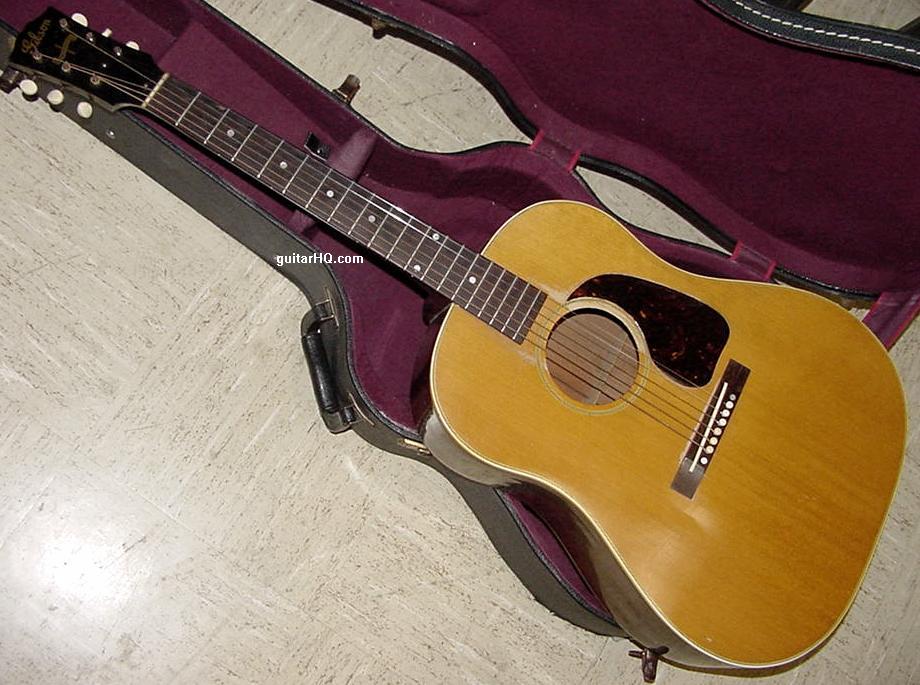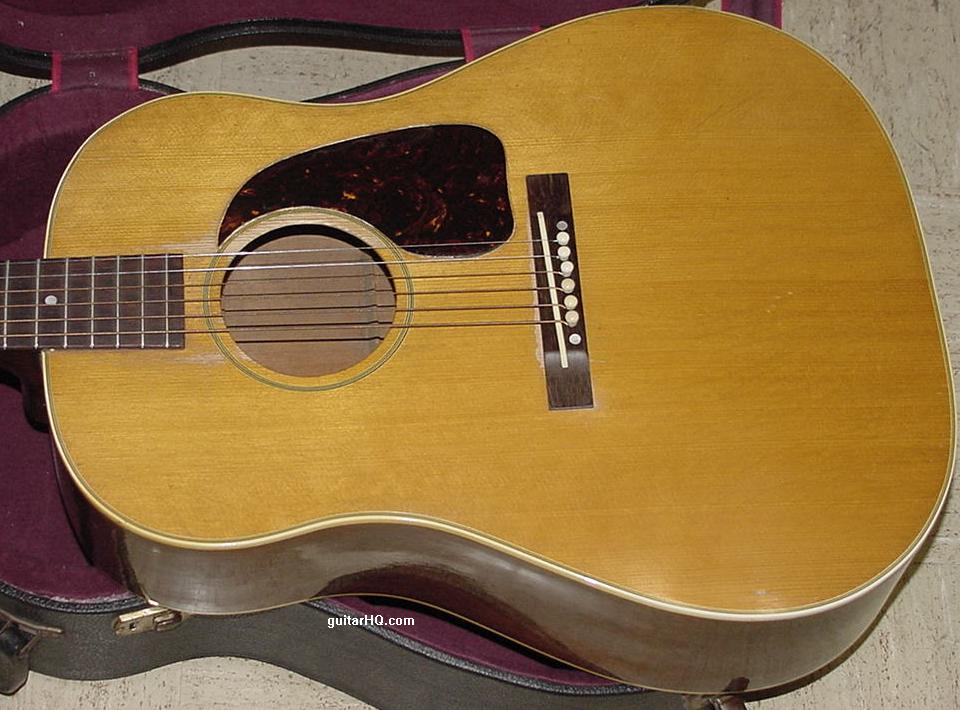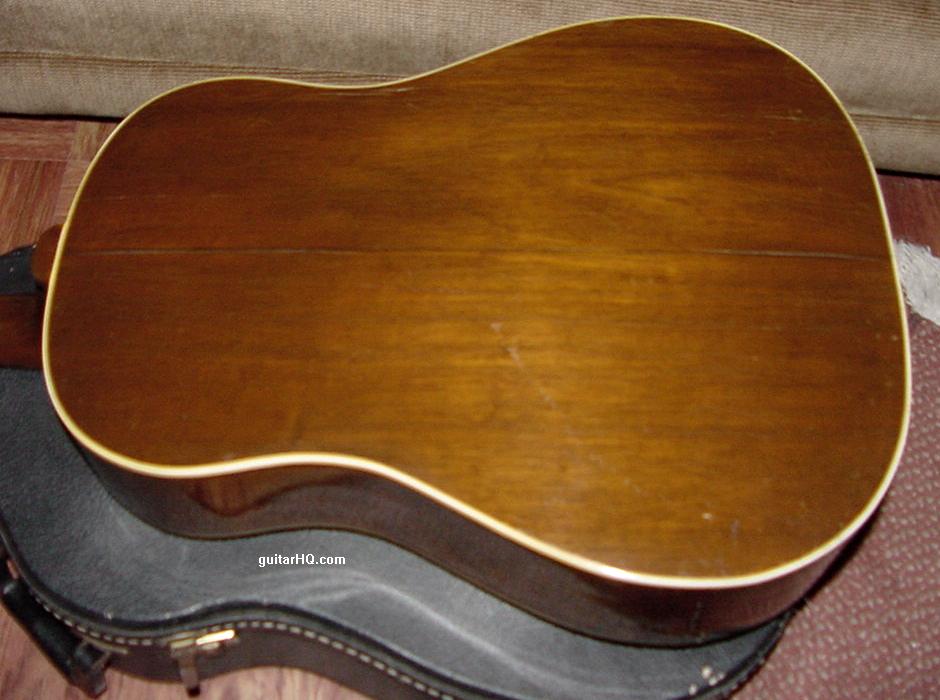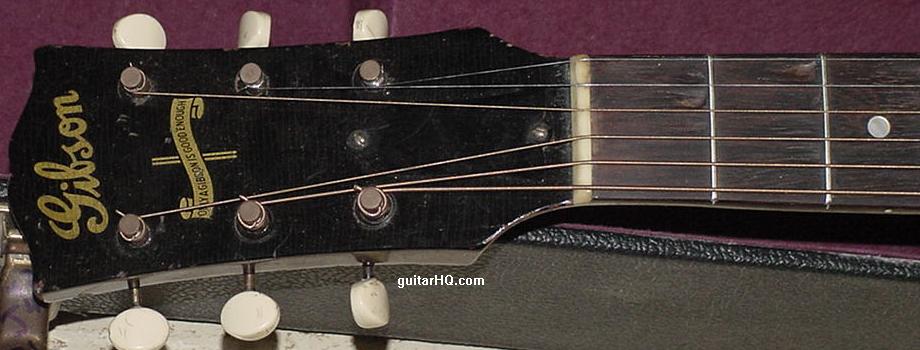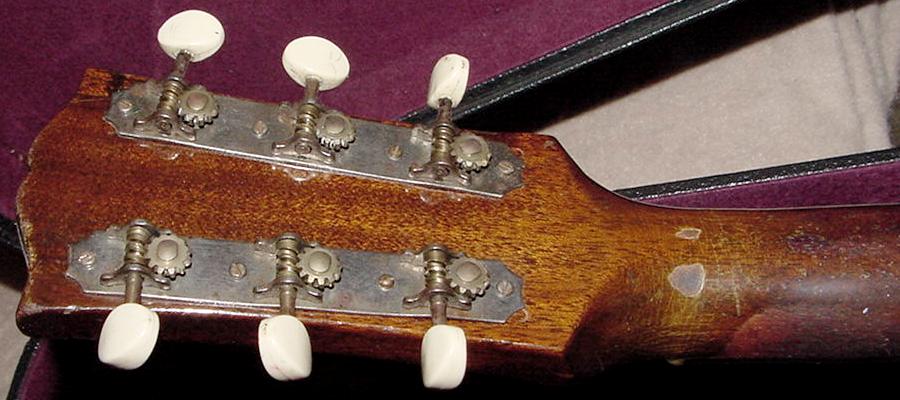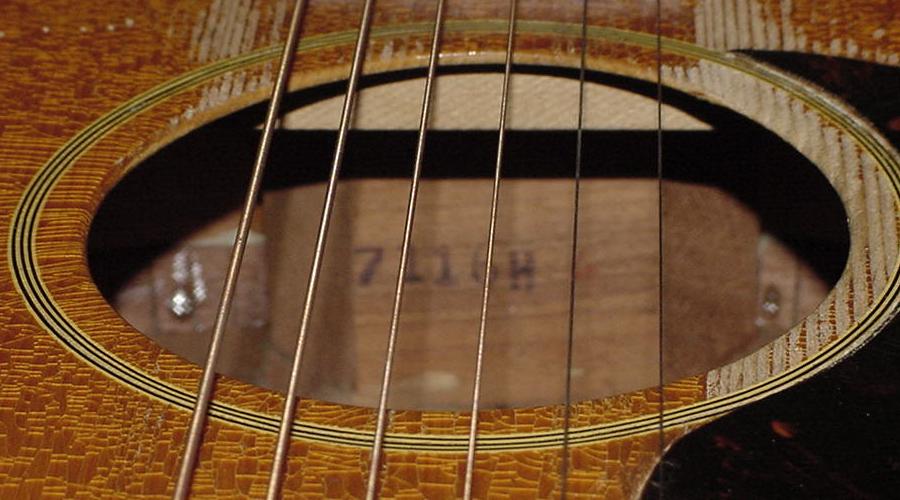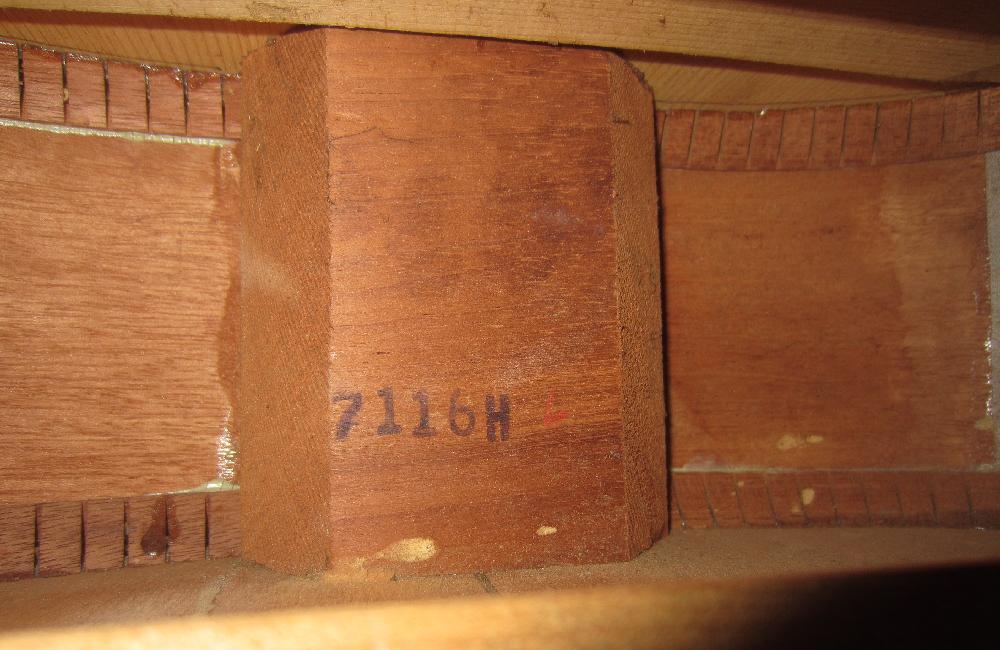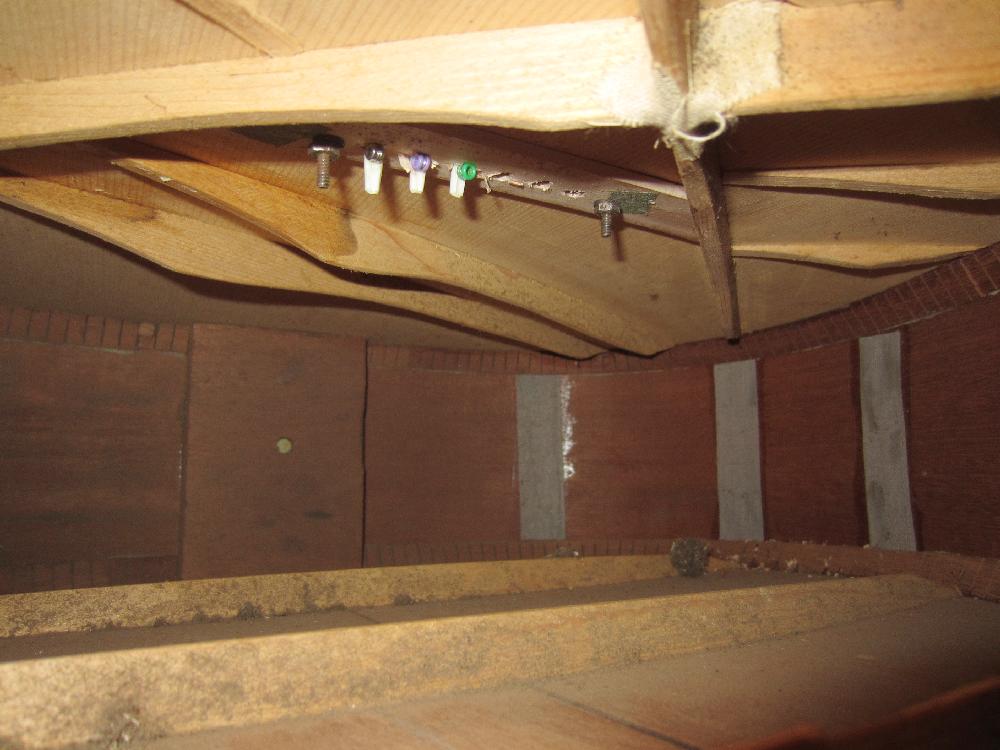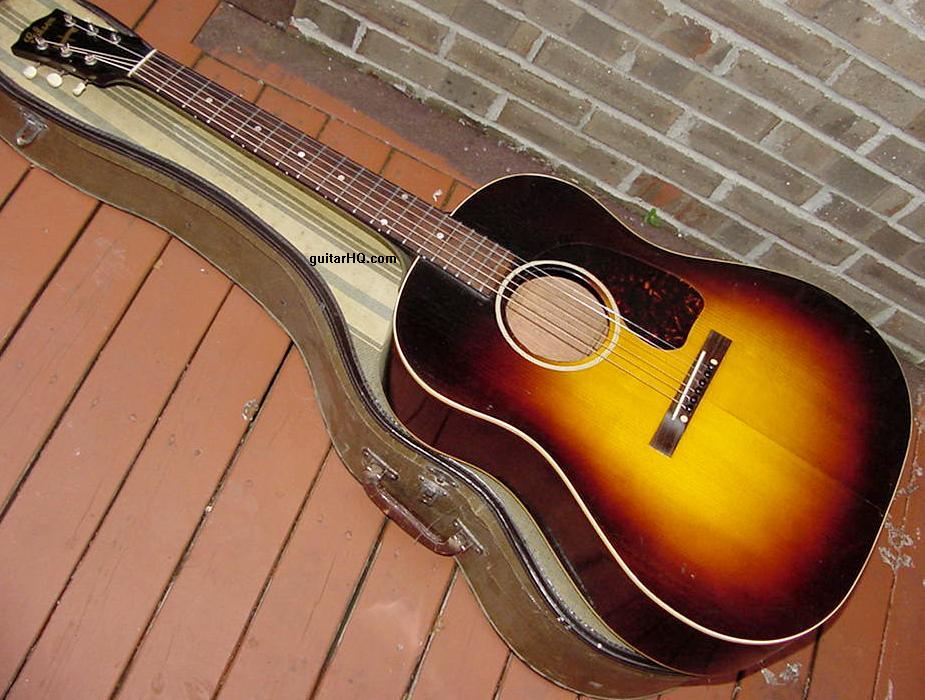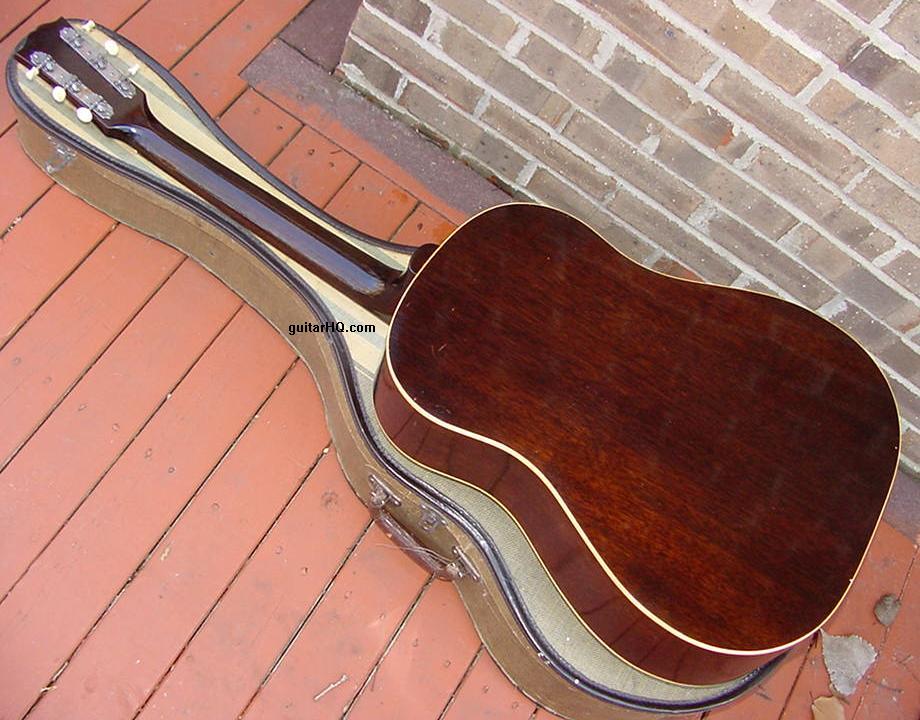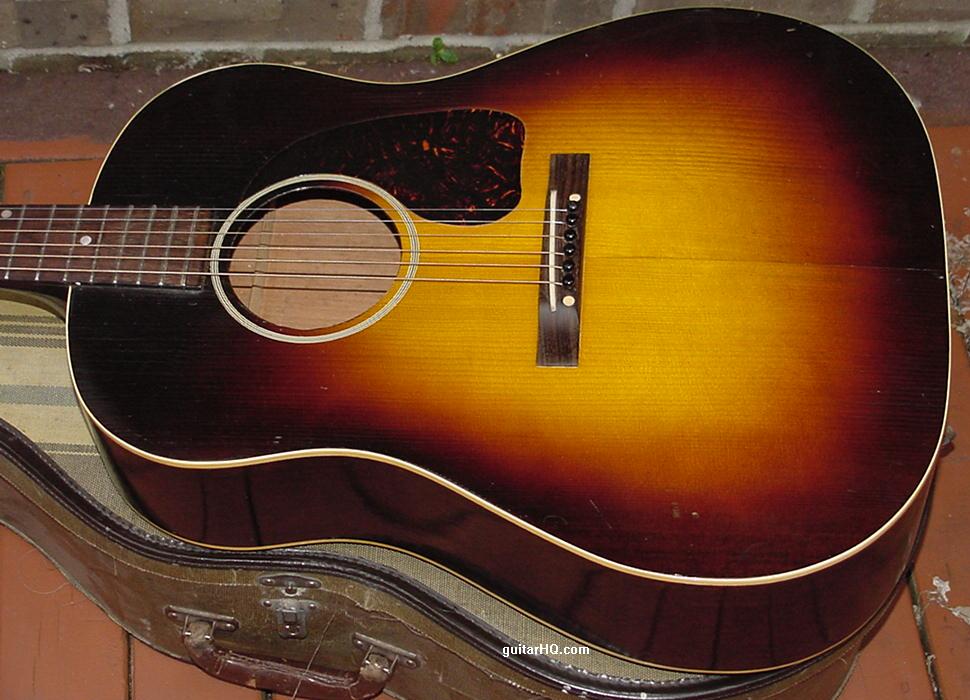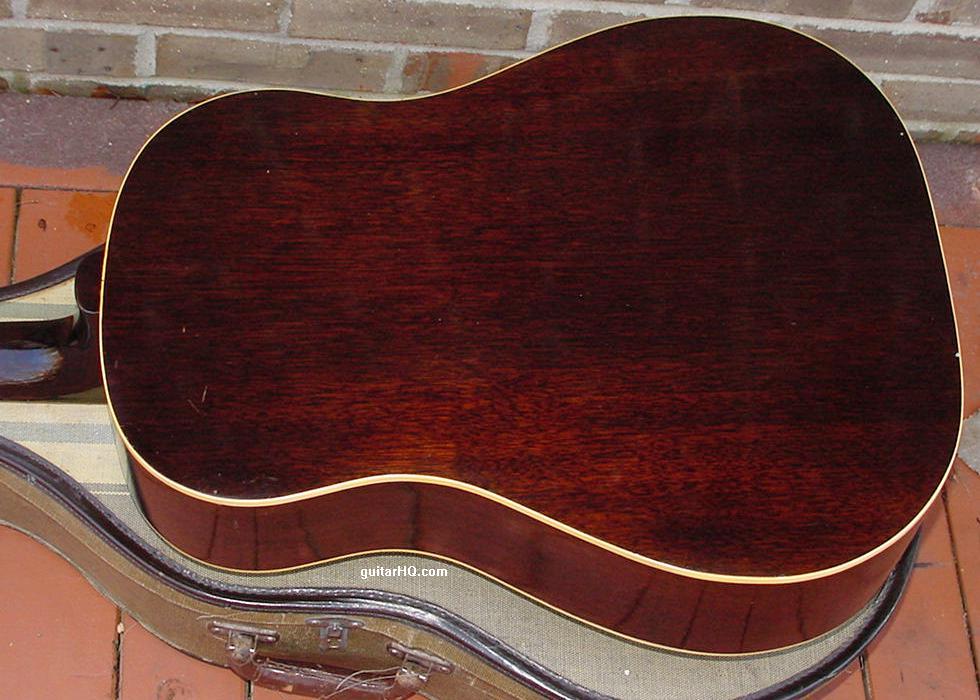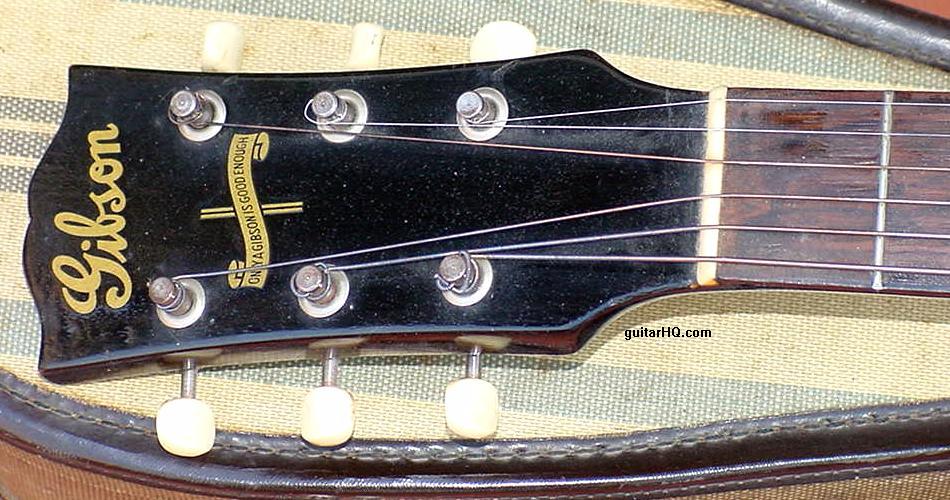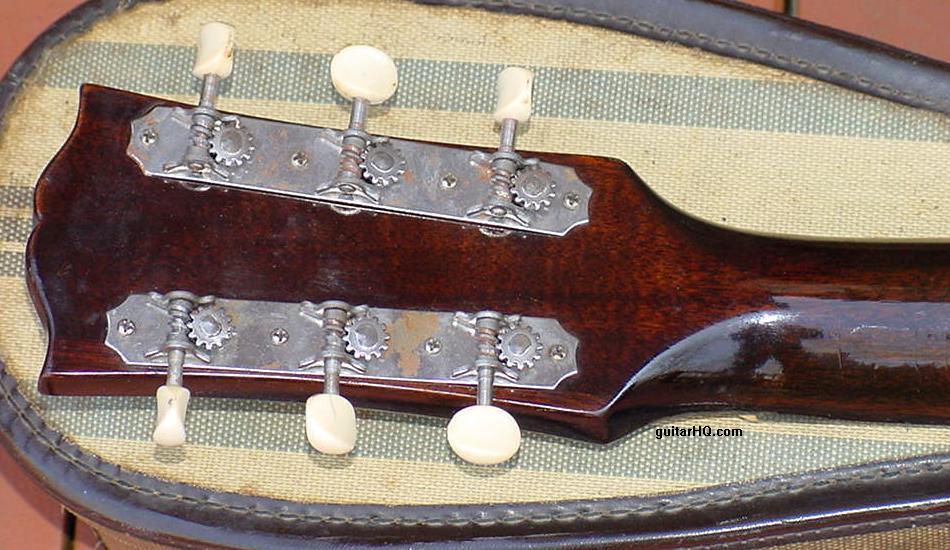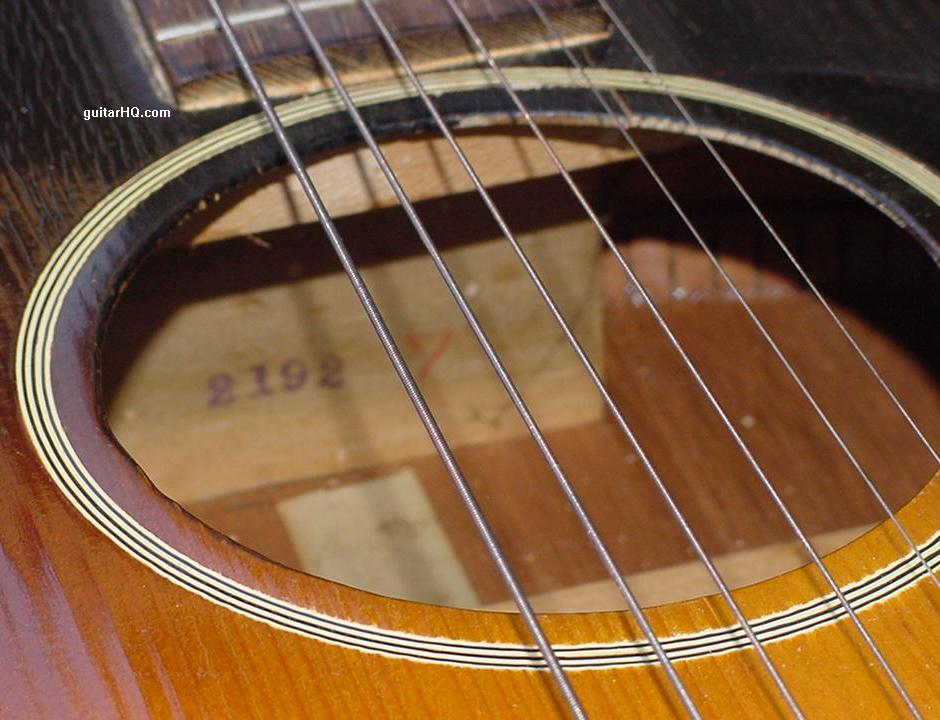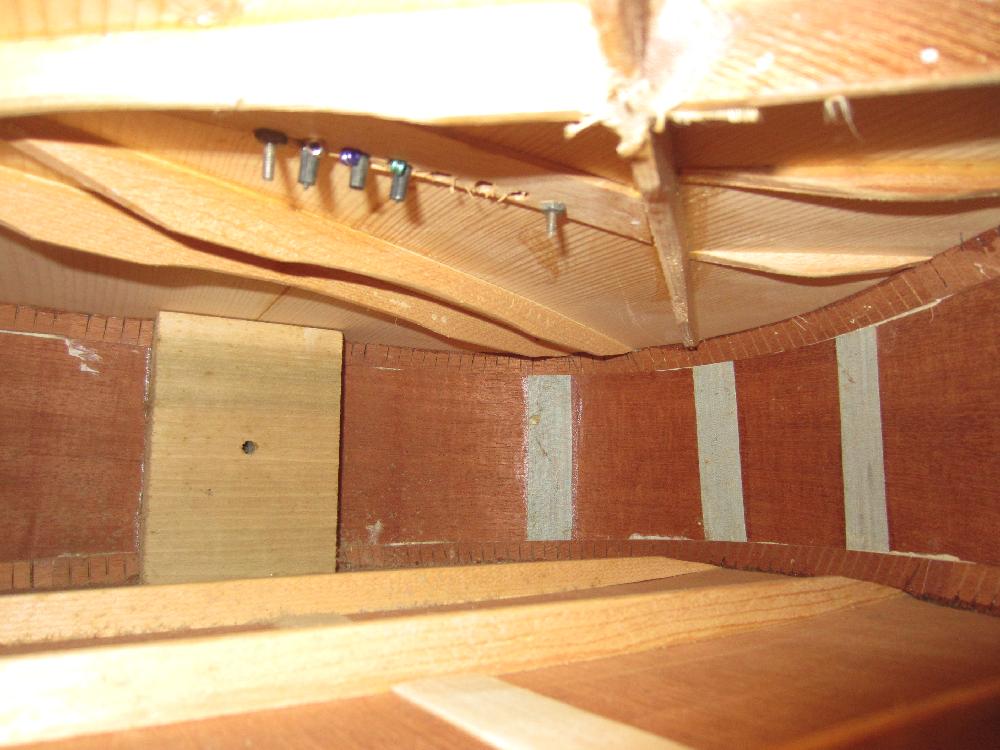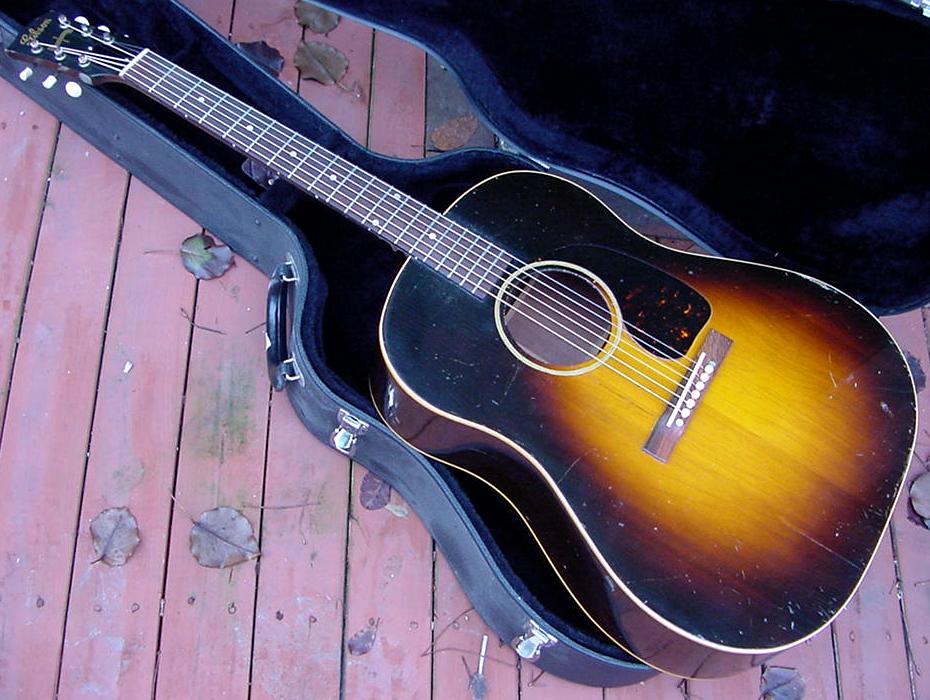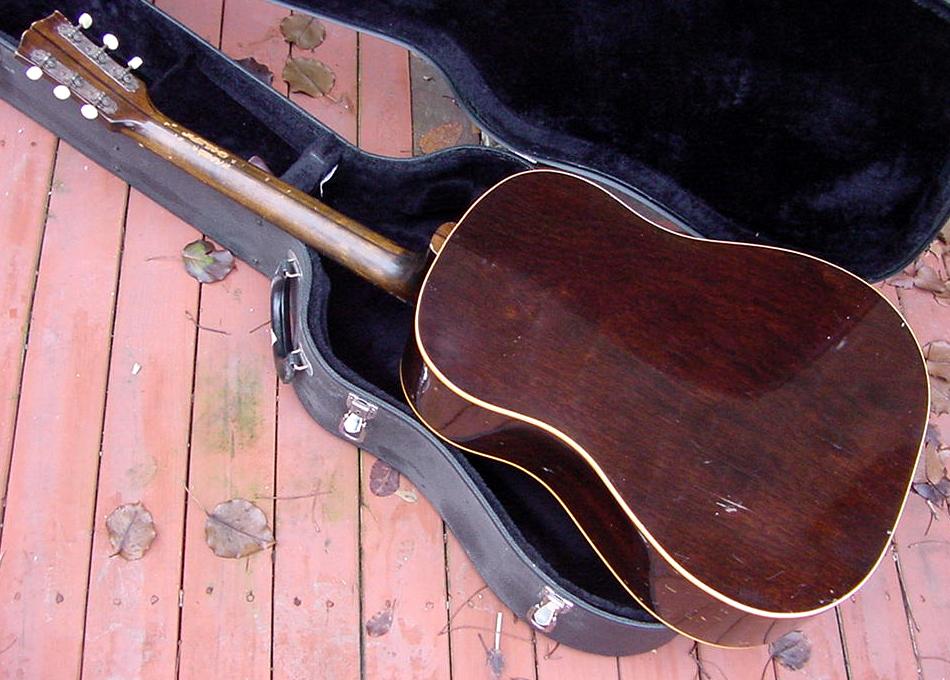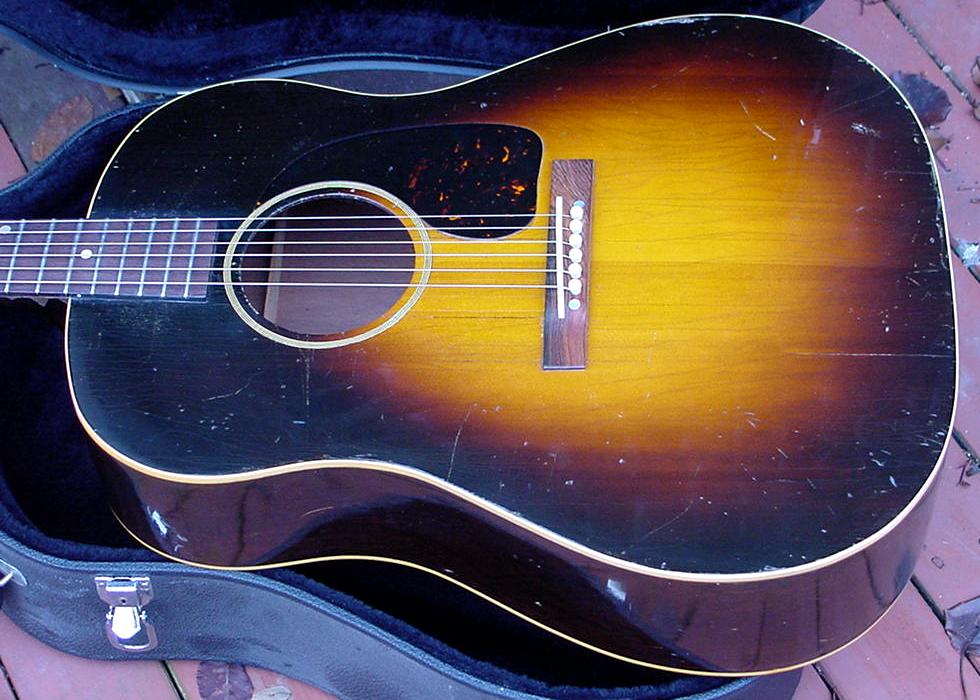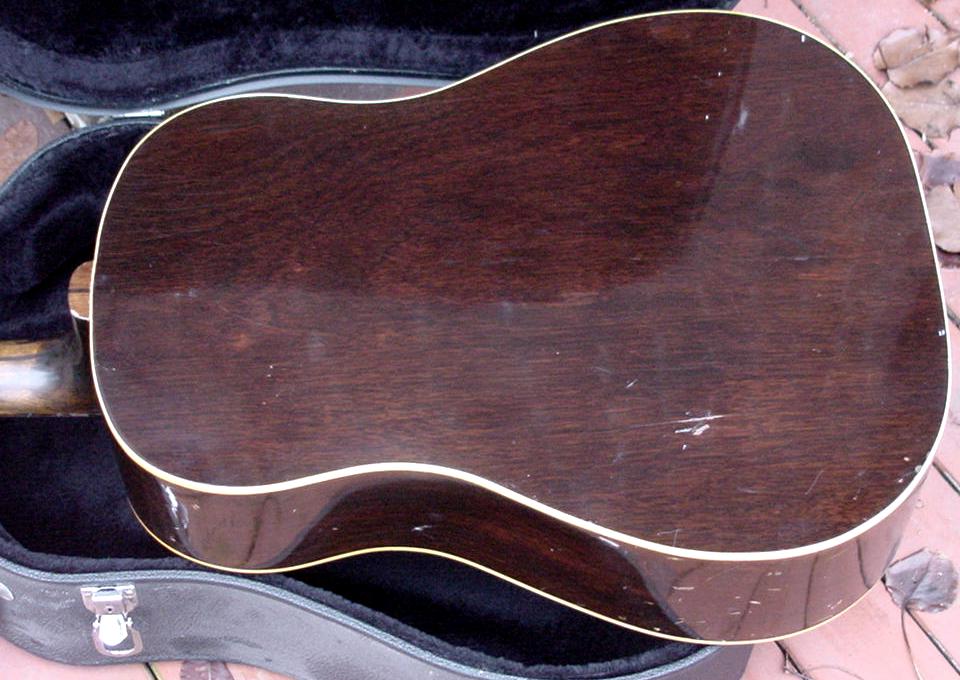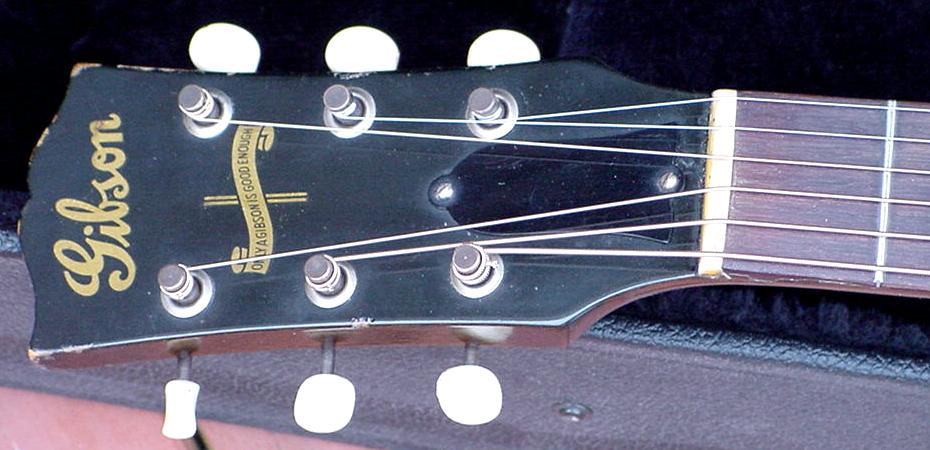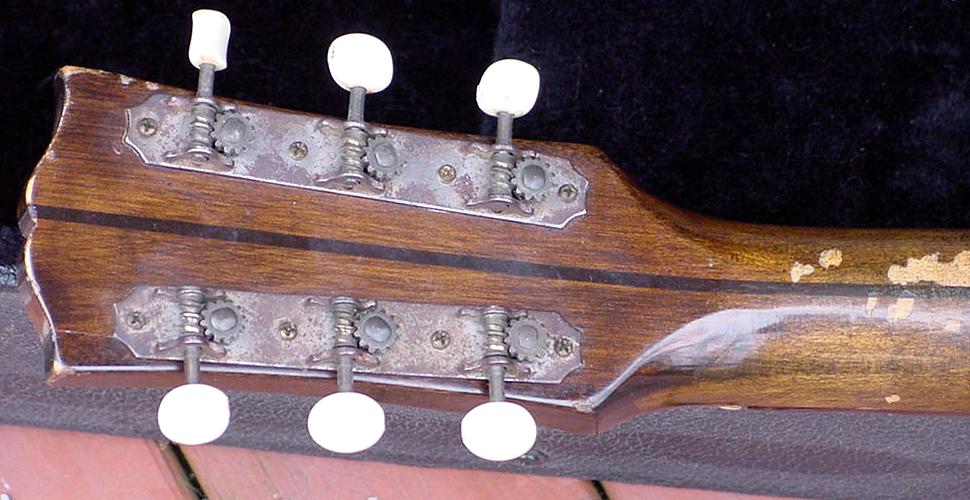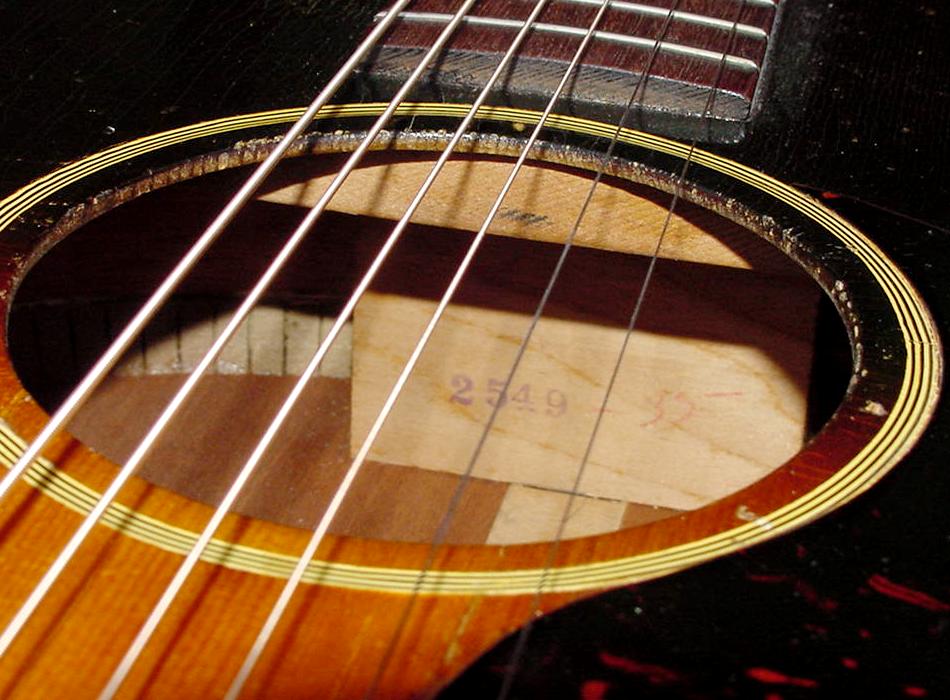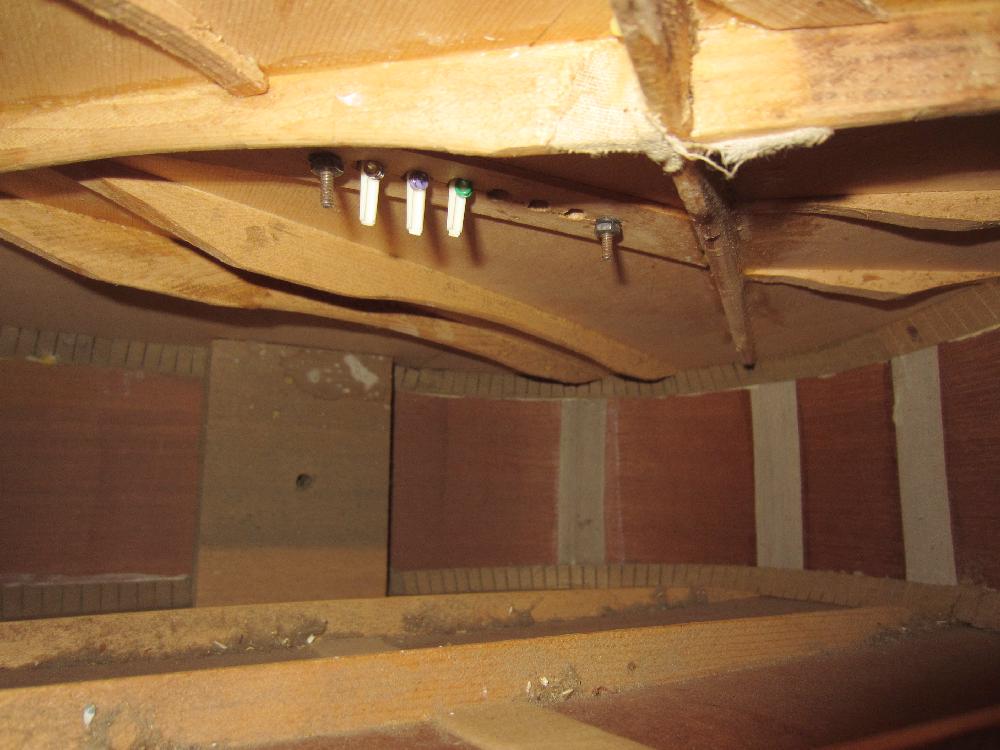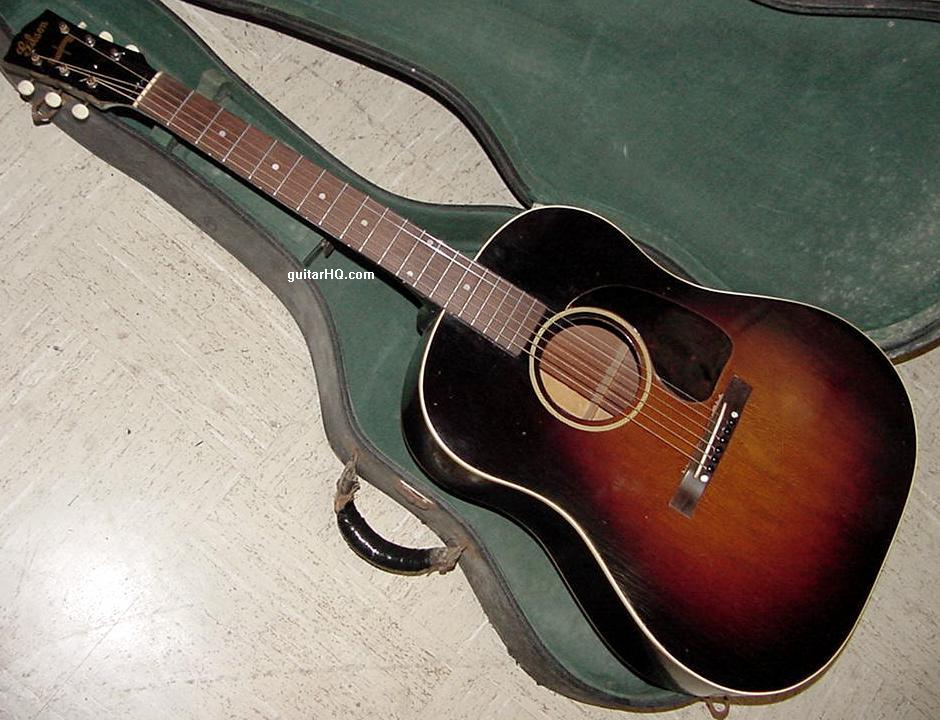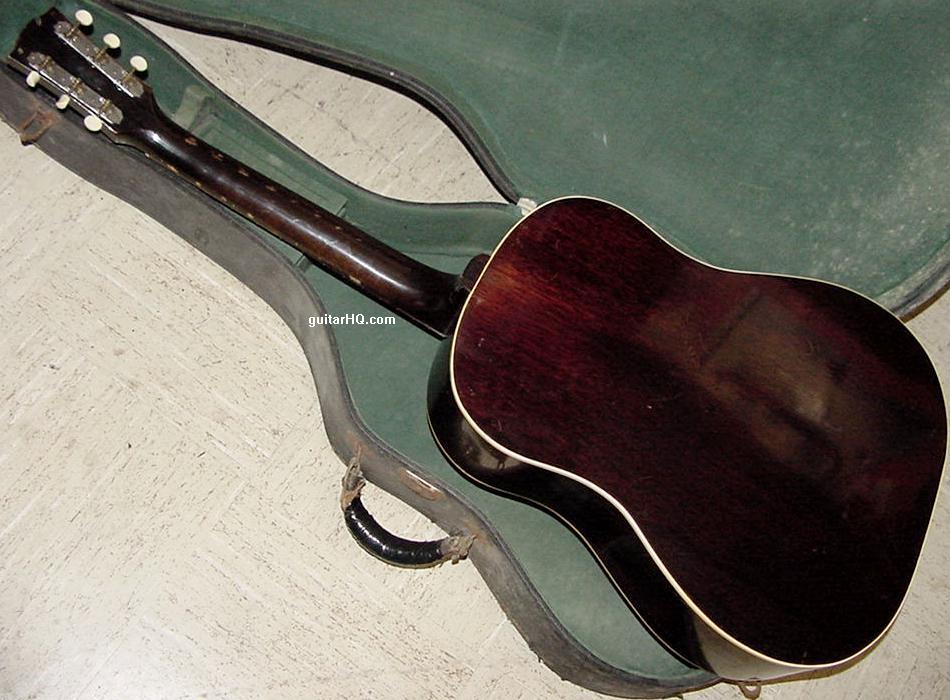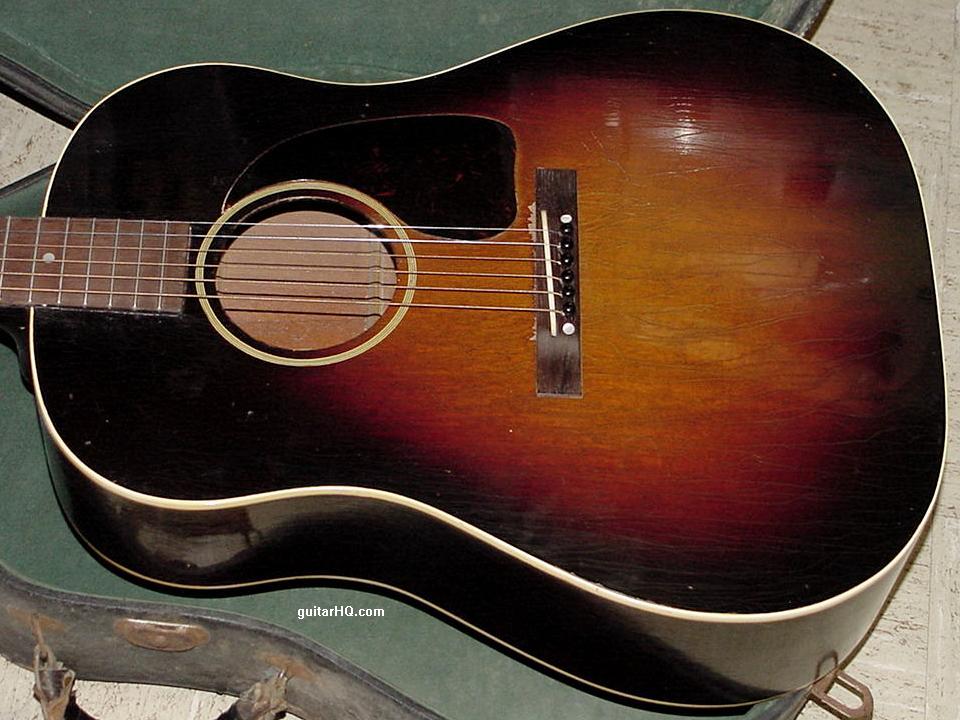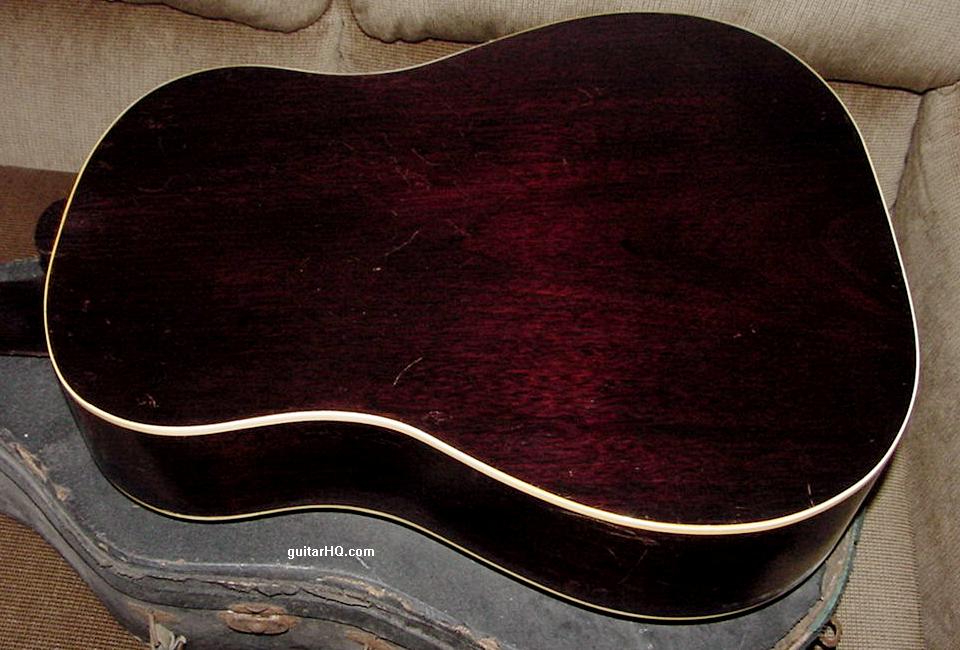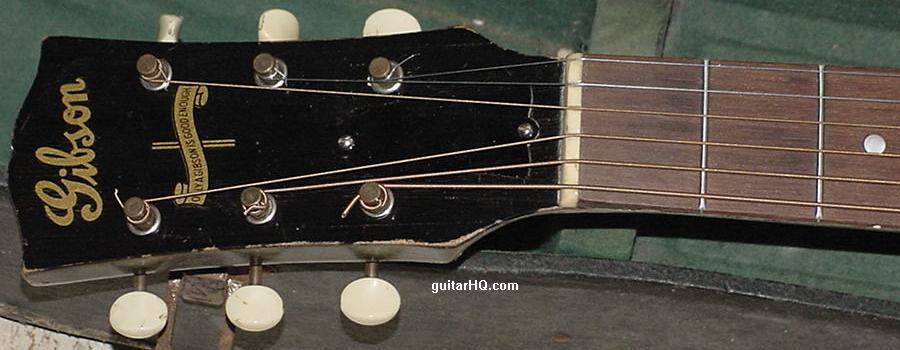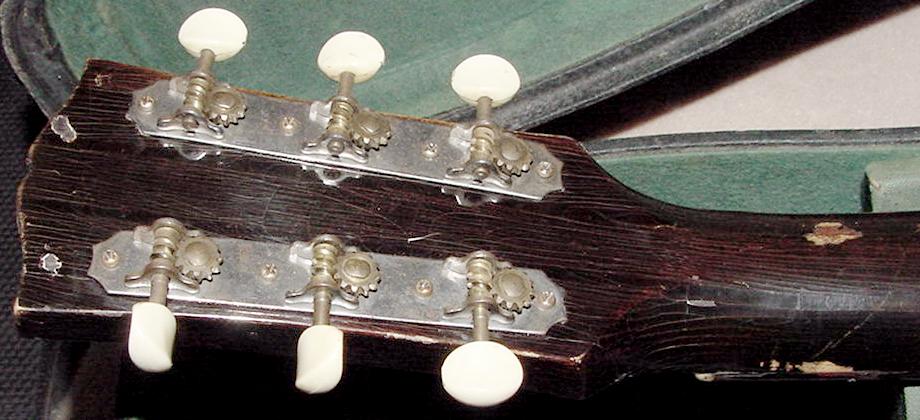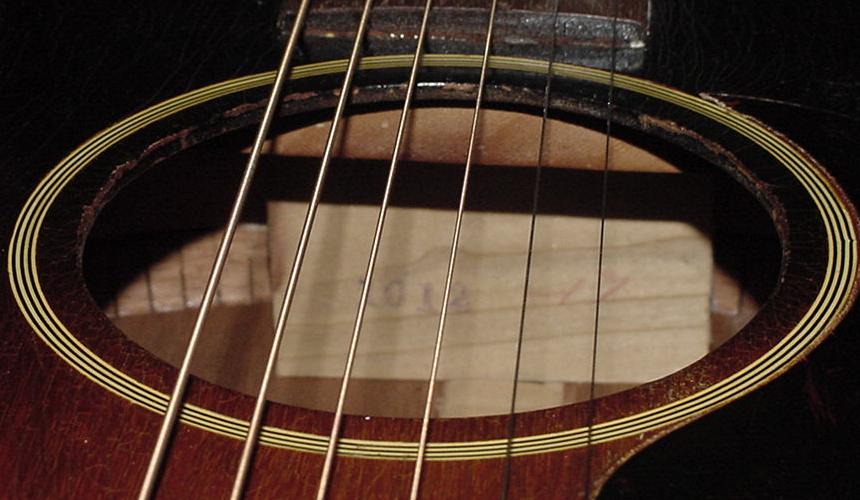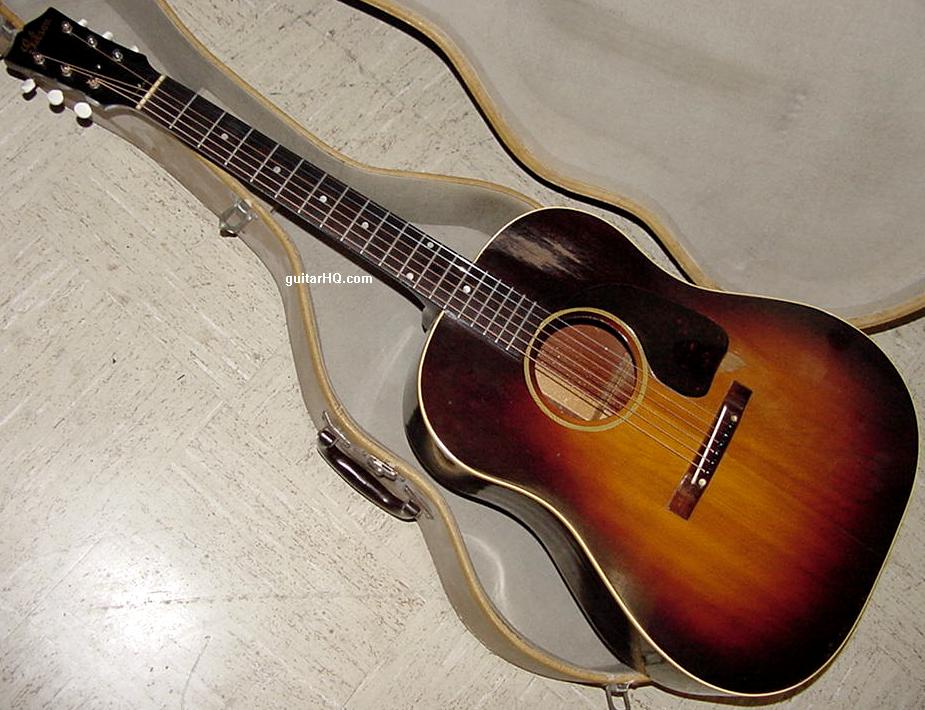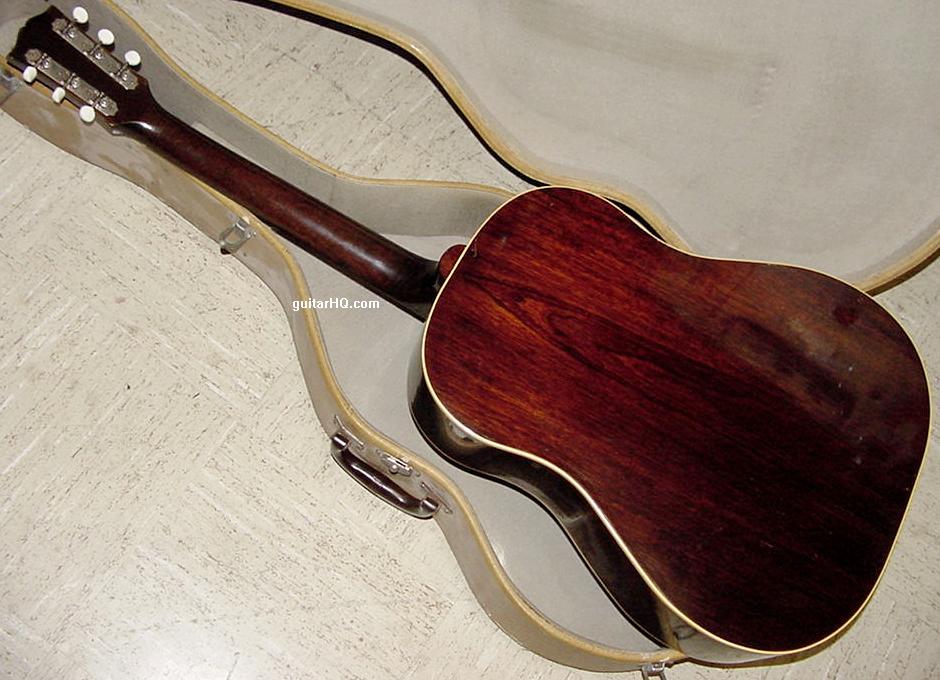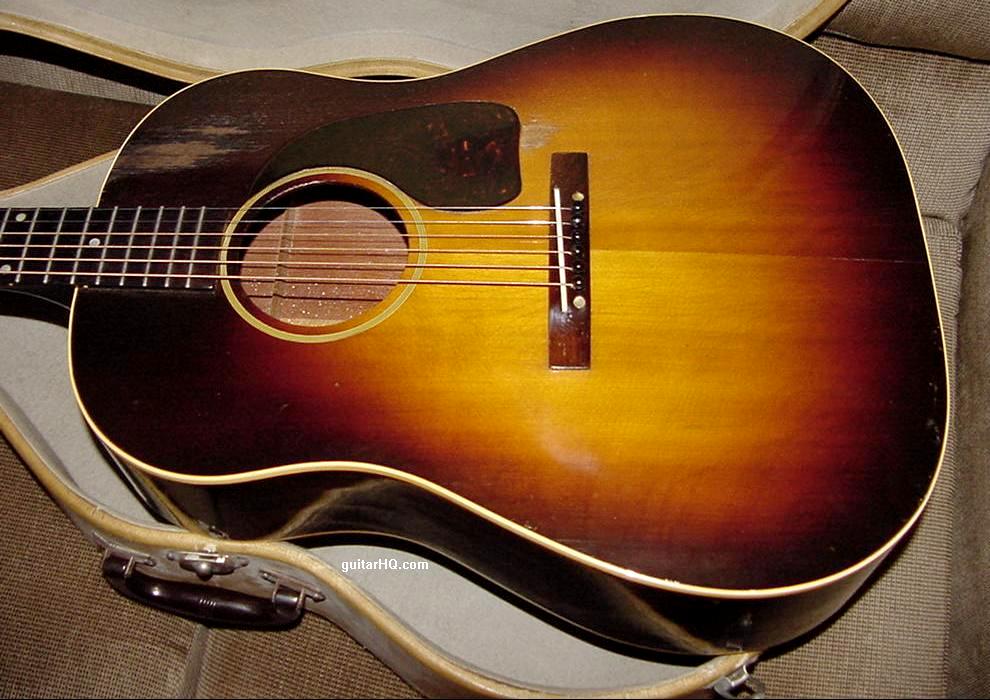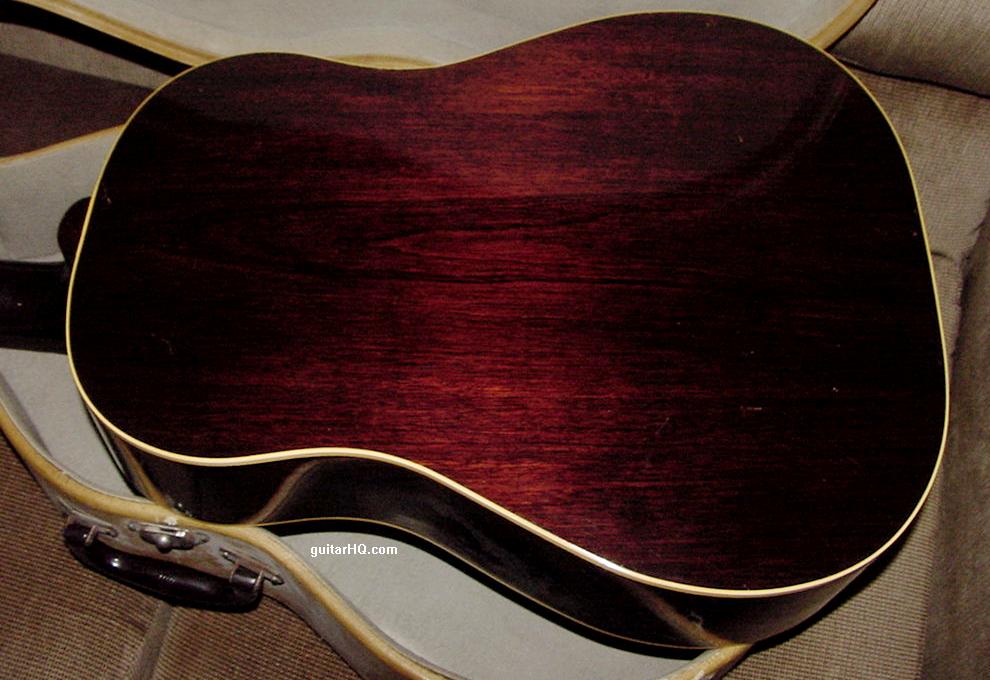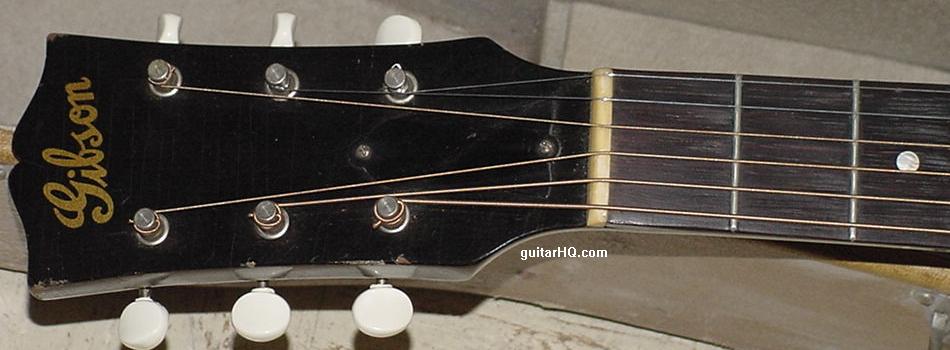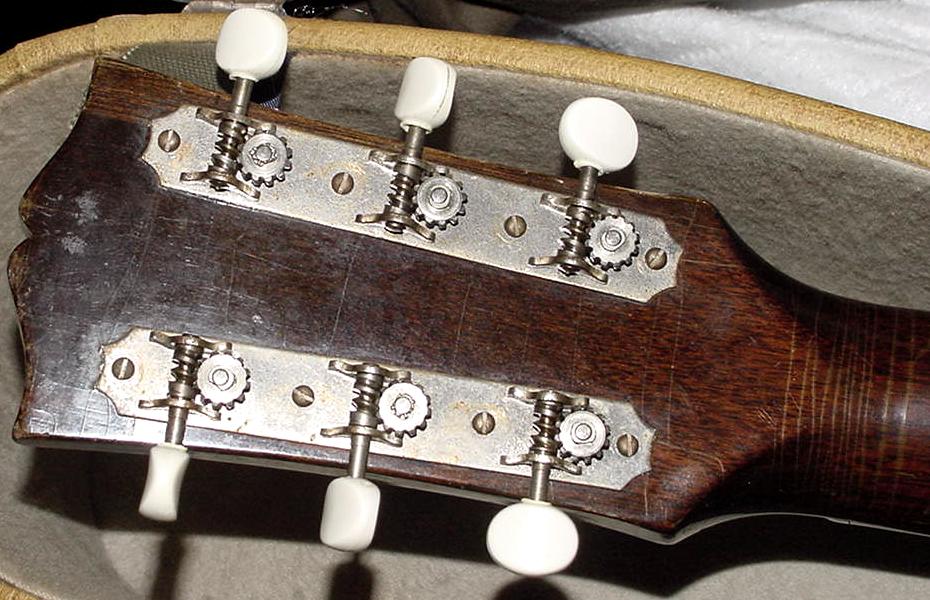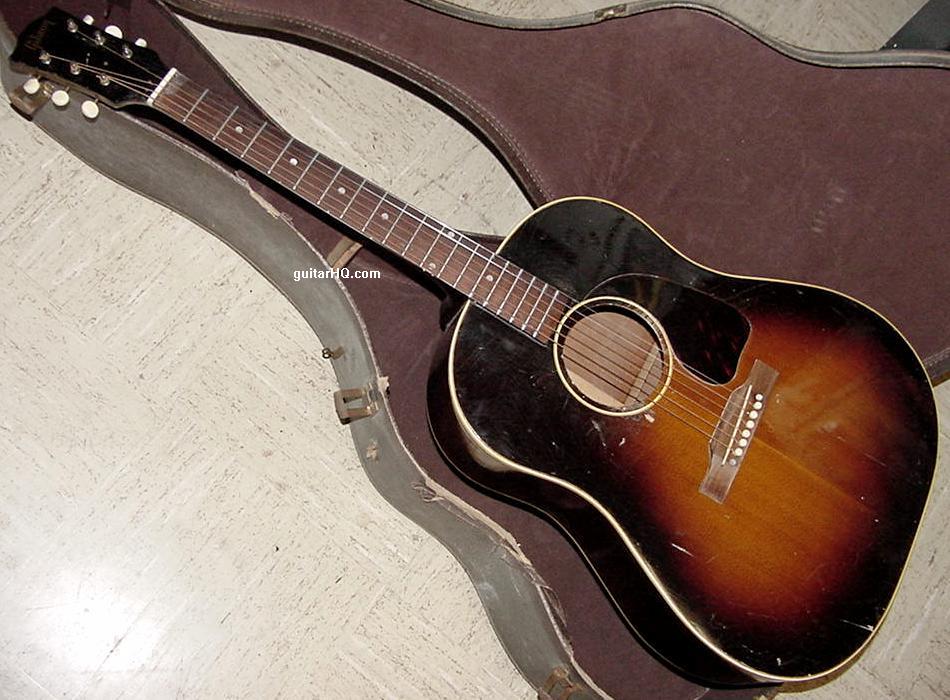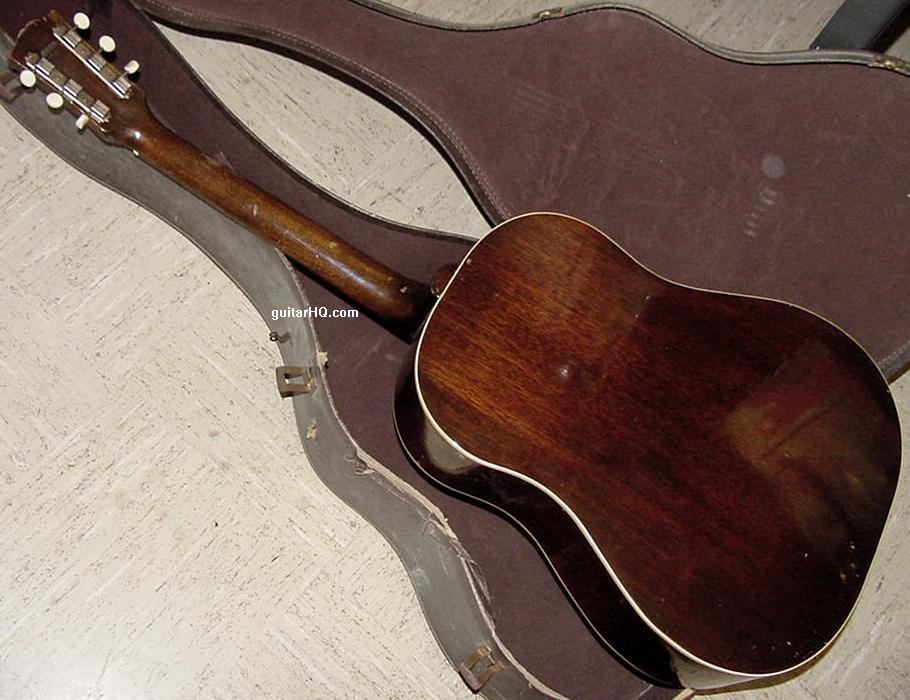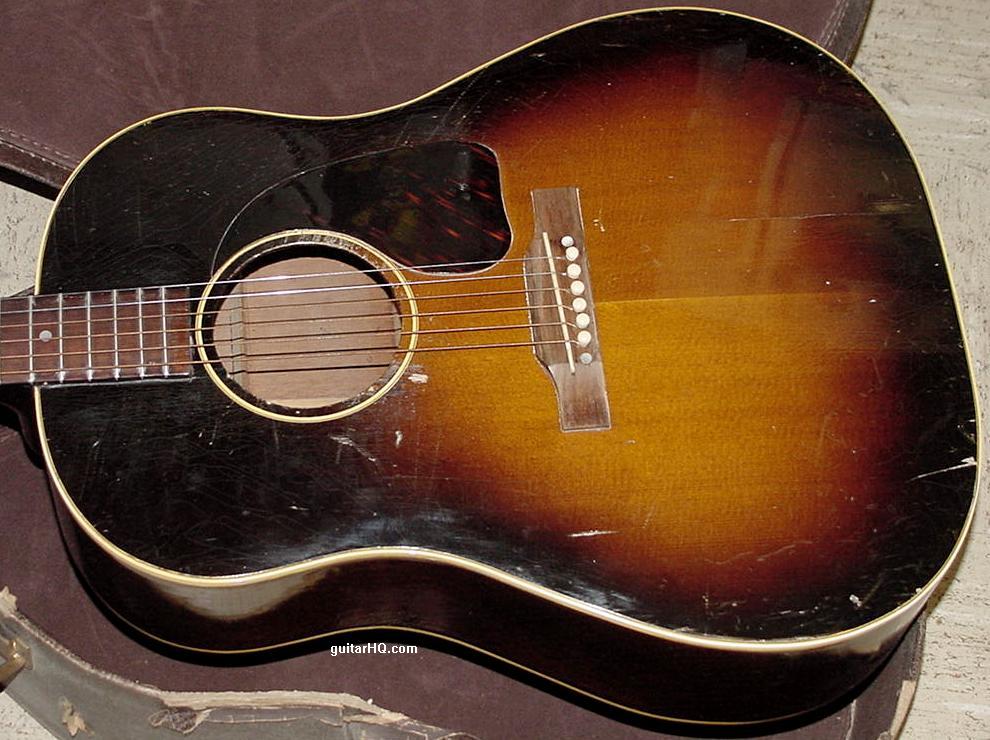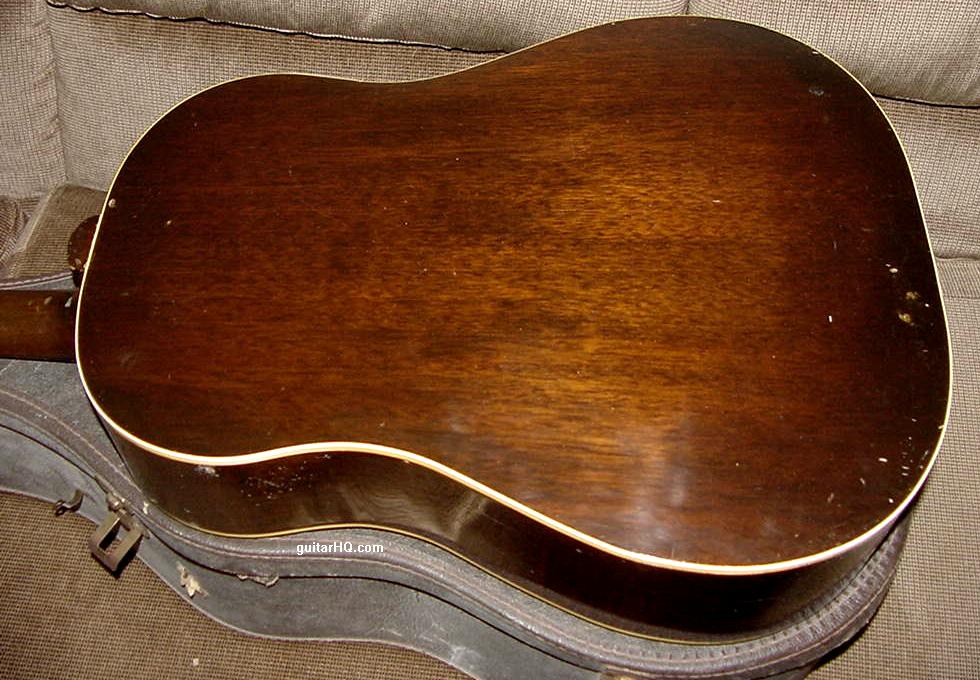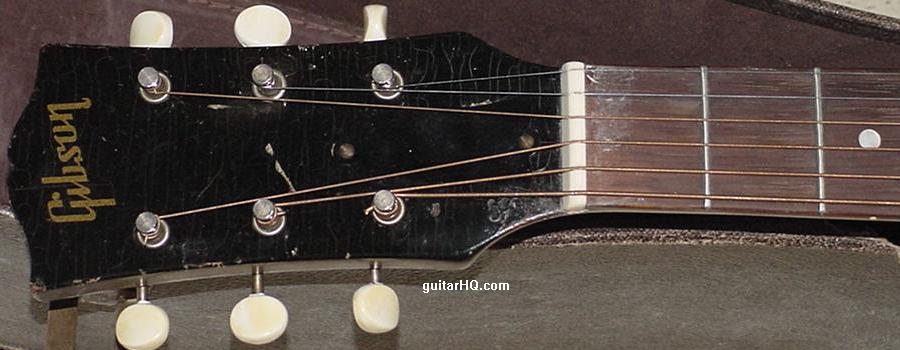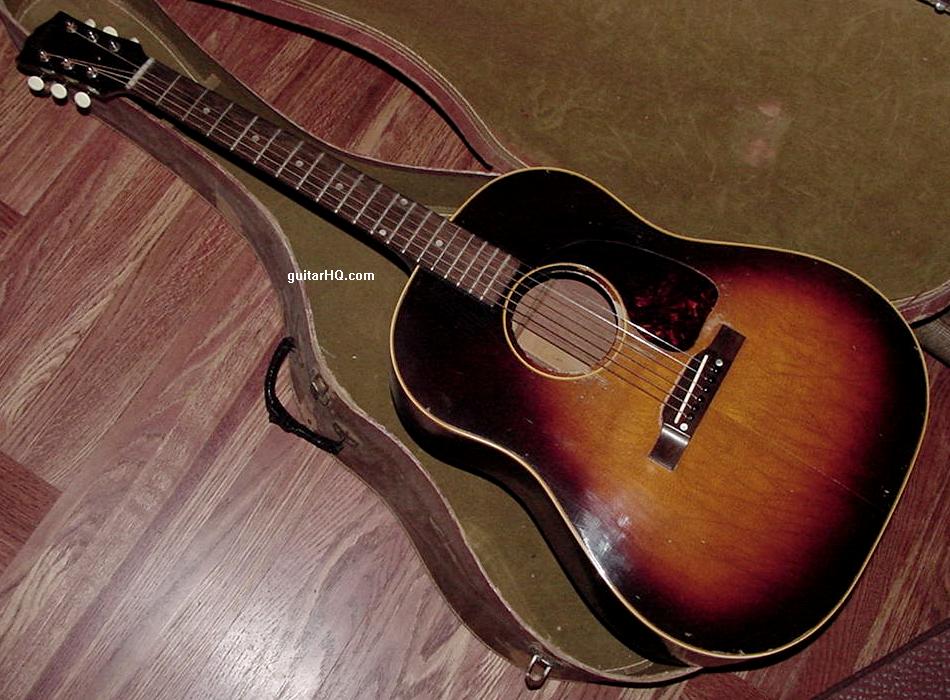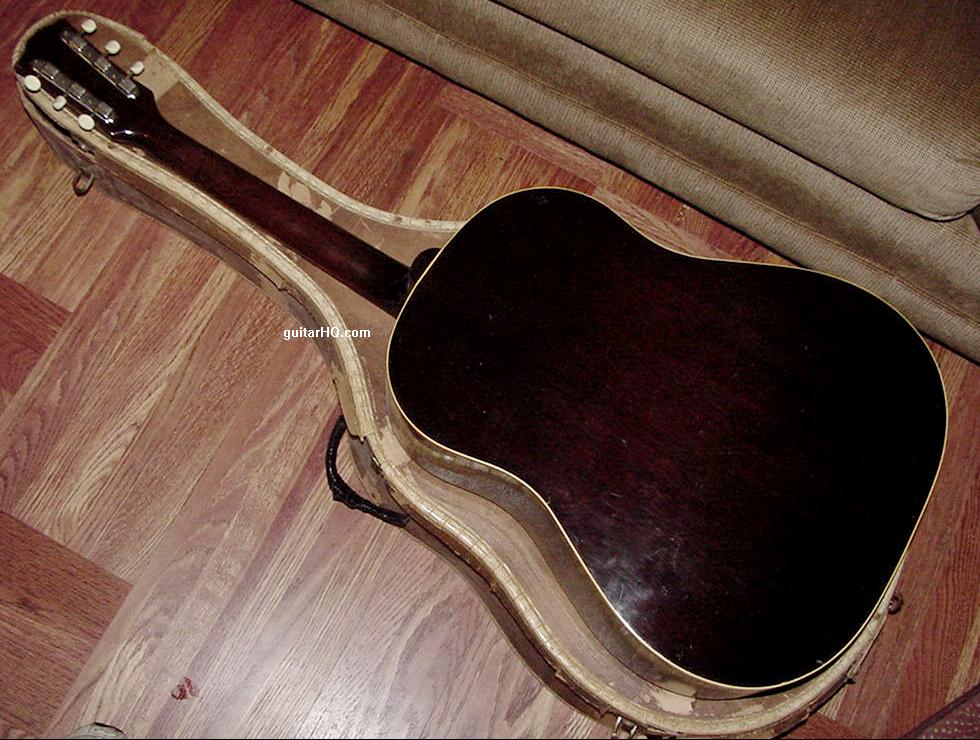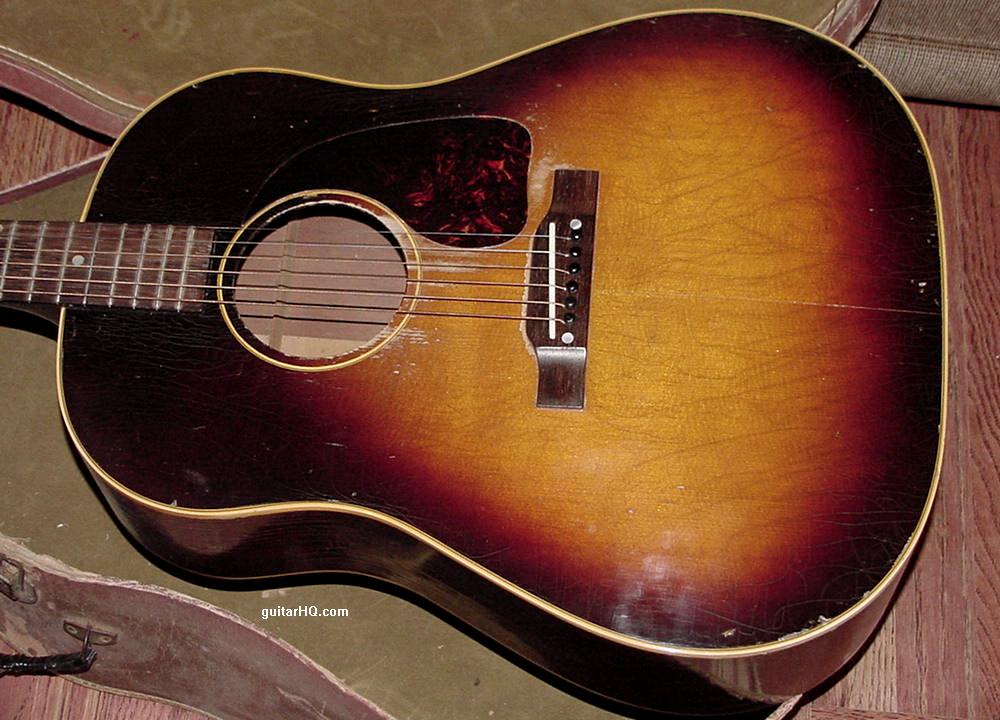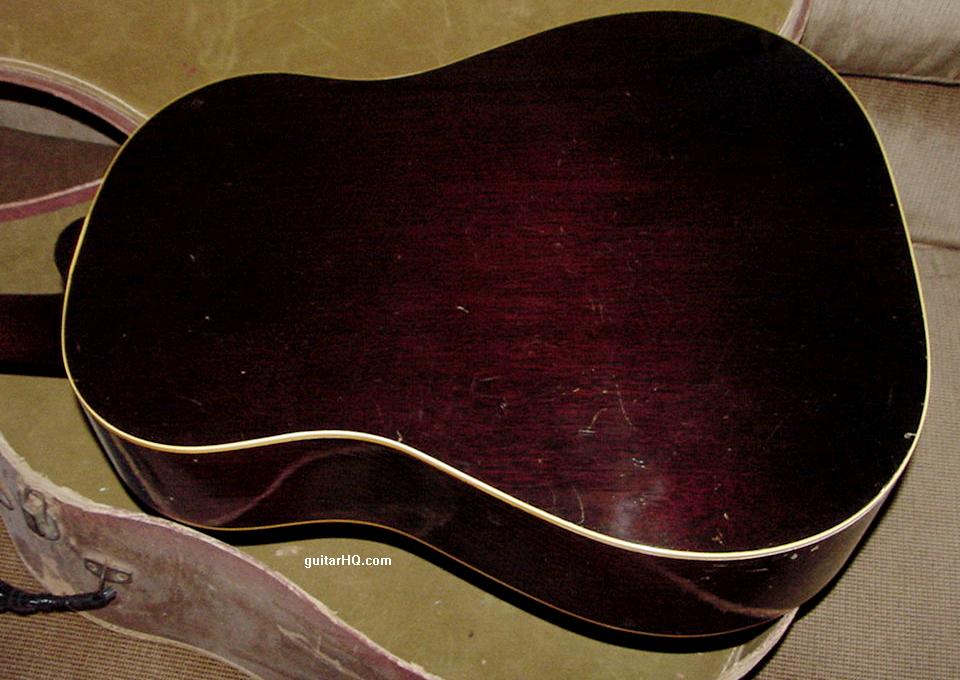Description: Gibson J-45 flat top guitar
Available: August 1942 to present.
Collectibility Rating: WW2 war-time 1940's models: B+. Late 1940s/early 1950's models: B.
Late 1950s model: B-. 1960's models: C-.
General Comments:
Initially, the Gibson J45 guitar differed only slightly from the
discontinued J-35. Internal contruction changes from the J-35
included top bracing strenghtened slightly with 1" set "X" brace
behind the soundhole, tall and thin back braces, and most importantly,
scalloped tall and thin top braces. Also the J-45 had a baseball bat style neck
(instead of the J-35's "V" style neck, used on pre-1939 models), and a
tear drop pickguard. Sunburst was the only finish available for the J-45
(or most any war-time Gibson guitar, as a sunburst finish can hide wood
flaws, an important feature during WW2 when wood supplies were short).
After WW2 the J-45 stayed sunburst, with a blond version being introduced
in 1947 and called the J-50.
But in reality the J-50 preceded the the J-45 by one month. On June 1, 1942, the first batch of blond J-50 (J-45n) models was shipped to Myers Music (Ohio.) And then that was it, no more, until after the war, making a banner logo J-50 (J-45N) a very rare guitar. Starting in August 1942 the J-45 (sunburst) is shipped, and is shipped through the war years, unlike the J-50.
The J45 guitar is probably Gibson's most popular acoustic guitar ever made. At the time, they were not an expensive or fancy guitar. But they are a good one! The sound of a J-45 is very warm and fat. Playability of the Gibson J-45 is excellent too. This makes the Gibson J-45 one of the best and most popular flattop Gibsons to ever be produced. Also, since the Gibson J-45 guitar was in production for so long, J-45s are easier to find than most any other Gibson flattop model (lucky for us!) If I was stranded on a desert island with $45 dollars to my name (the price when introduced) and could have only one Gibson flattop, a 1940s or 1950s J-45 would be it!
By the late 1950s and 1960s the J-45 went through some changes, unfortunately none of them good. The worse thing Gibson did to the J-45 was to make the J-45ADJ (a J-45 with an adjustable bridge). The adjustable bridge sucked the life and tone from the J-45, and really killed the model (at least in my eye). Yes you can convert the adjustable bridge to a non-adjustable, but then it's not original any more. A "catch 22" at least to me, so I generally avoid the J-45 ADJ models.
If you need to figure out the exact year of your Gibson J45 guitar, use the FON Factory Order number. This is located inside the body's sound hole on the neck block. See the Gibson Serial Number Info web page for help determining the exact year.
1940s J-45/J-50 FON numbers by J.Spann.
Joe's book lists a lot of FON numbers for 1940-1945, but unfortunately
doesn't largely specify exact years during this period. Here's the J45 FONs listed,
but not specific to any particular year (other than "1940-1945").
Just knowing what I know, I've tried to assign some years to these FONs.
Hope this is somehow helpful. And yes there are some J-45's listed as 1941.
I know this seems outside the normal 1942 introduction date, but this is the
info we have from Joe's book, and I see no reason to dispute it. (Though
any "1941 J-45" does seem to really be a 1942 model by all other standards.)
Remember in 1945 Gibson didn't seem to use FON numbers on J-45's, so there
aren't any listed below.
- 1941: 320 = J-45
- 1941: 483 = J-45
- 1941: 966g = J-45
- 1941: 4043 = J-50
- 1941: 4235g = J-45
- 1941: 4803g = J-45
- 1942: 7114h = J-45
- 1942: 7115h = J-45
- 1942: 7116h = J-50
- 1942: 7117h = J-50
- 1942: 7118h = J-50
- 1942: 7119h = J-50
- 1942: 7433h = J-45
- 1942: 7434h = J-45
- 1942: 7462h = J-45
- 1942: 7463h = J-45
- 1942: 7702h = J-45
- 1942: 7716h = J-50
- 1942: 7717h = J-50
- 1942: 7720h = J-45
- 1942: 7721h = J-50
- 1943: 907 = J-45
- 1943: 916 = J-45
- 1943: 928 = J-45
- 1943: 923 = J-45
- 1944: 1012 = J-45
- 1943: 2004 = J-45
- 1943: 2109 = J-45
- 1943: 2142 = J-45
- 1943: 2143 = J-45
- 1943: 2149 = J-45
- 1943: 2192 = J-45
- 1943: 2220 = J-45
- 1943: 2221 = J-45
- 1943: 2222 = J-45
- 1944: 2314 = J-45
- 1944: 2315 = J-45
- 1944: 2316 = J-45
- 1944: 2364 = J-45
- 1944: 2407 = J-45
- 1944: 2408 = J-45
- 1944: 2409 = J-45
- 1944: 2420 = J-45
- 1944: 2454 = J-45
- 1944: 2455 = J-45
- 1944: 2513 = J-45
- 1944: 2514 = J-45
- 1944: 2549 = J-45
- 1944: 2550 = J-45
- 1944: 2553 = J-45
- 1944: 2556 = J-50
- 1944: 2558 = J-45
- 1944: 2565 = J-45
- 1944: 2569 = J-45
- 1944: 2655 = J-45
- 1944: 2667 = J-45
- 1944: 2681 = J-45
- 1944: 2684 = J-45
- 1944: 2712 = J-45
- 1944: 2730 = J-45
- 1944: 2732 = J-45
- 1944: 2762 = J-45
- 1944: 2890 = J-45
- 1944: 2904 = J-45
- 1944: 2907 = J-45
- 1944: 2943 = J-50
- 1944: 2944 = J-45
- 1944: 2959 = J-45
- 1944: 2972 = J-45
- 1944: 3681 = J-45
If you have a vintage Gibson J-45 guitar for sale, please contact me at cfh@provide.net
- 1942 to 1944 J-45:
- 9xx FONs to 2xxx FONs red spruce tops - often lightly built, usually lighter than the 7xxxH examples and sound warmer but not as powerful with beautiful harmonics. These guitars differ the most since the tops differ in thickness and quality. The neck material and neck reinforcement has an impact as well.
- 1942 Gibson J-45 introduction specs:
- 16" wide, round shoulder dreadnought shape, dark brown mahogany back and sides and neck (J-35 had chocolate or dark red colored back/sides/neck), solid spruce top with scalloped X-bracing, gold silkscreened peghead logo (J-35 has white logo), slight inward "bend" of the peghead sides (J-35 has straight peghead sides), teardrop "firestripe" pickguard (J-35 had a pickguard which followed the body contours), 19 frets on the neck, black bridge pins, 2 pearl dots on rectangle bridge, 7-ply top binding and single layer back binding, multi-ply rosette binding (bridge rosette is J35 style with more layers), "Kluson Mfg Chicago" and "Pat." stamped into the plate in a circle around the attachment screws, plastic buttons (usually white but sometimes black). tall and thin back braces, 24.75" scale, 19 frets total on fingerboard. dot fingerboard inlays, "Only a Gibson is Good Enough" gold banner logo, brown sunburst finish. Note 1942 models have higher tuner position on the peghead, leaving less room for the banner logo. This was changed in 1943, moving the tuner slightly closer to the nut, giving more room for the banner logo. (Easy to see, 1942 models have the "D" tuner almost touching the bottom of the "G" in the Gibson logo.) Note there was a batch of a few natural finished J-45N (or J-50 if you prefer) models made during June 1942 (see pictures below). First FON (factory order number) of J45s in 1942 was 907 (and 923). Bracing for FON 7xxxH and some 9xx FONs was basically the same as the third J-35 issue of two nonscalloped tonebars. This style of J-45 with the striped pickguard and circle logo tuners ended around FON 2221. Note the striped pickguard *occasionally* appears on J45 and LGx models during 1947, 1948 and 1951.
First 1942 Gibson J-45 guitar "907" batch number (red pencil "-17" is the
guitar within that batch). This is the neck block seen through the sound hole.
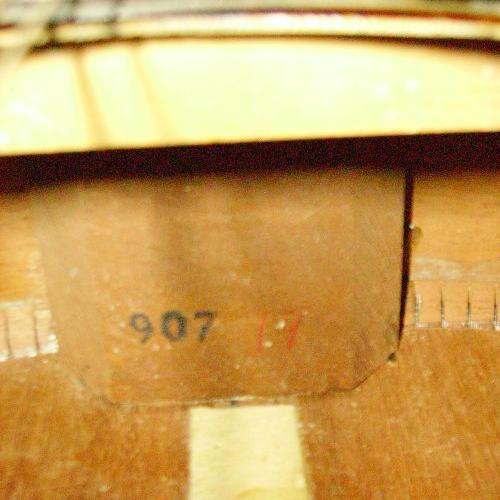
- Late 1942 Gibson J-45 specs:
- a tortoise-shell teardrop pickguard which replaced the firestripe material, single bound top and back, multi-bound rosette, Adirondack 2-piece spruce top, early examples have a Mahogany neck but a Maple neck with a single mahogany stripe down the center (3 piece neck) is more common. Three layer w/b/w top and single layer back binding. Mahogany neck block with beveled sides, but this soon changed to a mahogany neck block with square sides. Tuners were 3-on-a-plate Klusons with exposed gears and "Kluson Mfg Chicago" and "Pat." stamped into the plate in a circle around the attachment screws, plastic buttons (usually white but sometimes black), and 1/4" diameter posts. This style of tuner lasts into early 1943 (FON 2221 last documented series with this tuner style). By late 1942 Poplar neck blocks were used. (Late 1942 FON would be 2119, with FON 2143 being the last documented series with mahogany neck block.) Some FONs for 1942 include 7116-7119, 7434, 7705, 7721, 907, 910, 923, 928, 2004-2006, 2059, 2098, 2110, 2119. Bracing for 1942 to 1944 J-45 models (9xx FONs to 2xxx FONs red spruce tops) was often lightly built with full sound. These are usually lighter built than the 7xxxH FON examples, and sound warmer but not as powerful, with beautiful harmonics. These guitars differ the most since the tops differ in thickness and quality. The neck material and neck reinforcement also has an impact as well.
- 1943 J-45 specs:
- maple neck with two mahogany stripes down the center (5 piece neck), most with no truss rod (war time metal shortage), neck shape is usually HUGE because of the lack of a truss rod, Poplar neck block (instead of mahogany), rosette binding much simplier and not as many layers, Kluson tuners no longer had circle stamp (still exposed gears, but riveted instead of screwed in place) and shaft size decreased to 7/32" to save metal. Also the cog gears got thinner with no bevel on the cog edges. Tuner position moved towards the nut, giving more room of the banner logo on the peghead face. Also during 1943 some J-45 models had non-bookmatched two piece Adirondack spruce tops. Or some with four piece Adirondack spruce tops (four piece top J-45s still sound great, though they don't look as good). Even others had a black (skunk) strip down the middle of the top. Since Spruce was a restricted war-time material, many J-45 models from 1943 have a mahogany top instead of spruce. Some J-45s have laminated maple back and sides finished in a dark mahogany stain. A few J45s were made with a laminate maple back and a mahogany top. Factory Order Numbers (FON) in the 2100s to 2500s are common for 1943.
- 1944 J-45 specs:
- most J-45s now have a truss rod, still some J-45s made with mahogany top. Tuners change again with the cogs getting slightly thicker and with beveled edges. Also the tuners cogs are peened on the the shafts (not screwed, and the peening sometimes has a "waffle" design). Around May 1944 CMI was now Gibson's new owners, and they had some financial pull to get the new materials for guitars by mid-1944. Hence by mid 1944 two piece bookmatched Sitka spruce tops appear. Factory Order Numbers (FON) in the 2600s to 2700s now seen. In very mid to late 1944 the neck block switches back to mahogany, though poplar is still seen.
- 1945 J-45 specs:
- Mahogany neck block and Mahogany neck used again. Two piece bookmatched Sitka spruce top. Laminated maple back/sides (which was used sometimes in 1943/1944) is discontinued during 1945 (for example FON batch 2828 used maple back/sides). Factory Order Numbers (FON) in the 2800s to 2900s and 300s to 500s seen, and in the 600-800s and 1000s range. Then FON no longer used sometime in late 1945.
- 1946 J-45 specs:
- back, sides, neck again use mahogany exclusively, mahogany neck blocks also again used. No FONs used. The banner "only a gibson is good enough" logo is gone (but the old style "gibson" script gold logo is retained).
- 1947 Gibson J-45 guitar specs:
- the J-45's blond brother, the J-50, is introduced. The J-50 is identical to the J-45, except the top is natural instead of sunburst. Most 1947 models still have the script Gibson logo.
- 1948 Gibson J-45 guitar specs:
- newer post-war gold "Gibson" block logo.
- 1950 Gibson J-45 guitar specs:
- Upper belly bridge (belly towards sound hole) with white pins replaces the rectangle bridge, fabric side supports discontinued, triple bound top.
- 1952 Gibson J-45 guitar specs:
- fabric side supports are no longer used.
- 1955 Gibson J-45 guitar specs:
- shorter unscalloped top braces replaces the taller scalloped braces, larger pickguard with point at upper bout, an additional 20th fret added to the fingerboard.
- 1956 Gibson J-45 guitar specs:
- Adjustable bridge saddle optional (named the J-45ADJ, not desirable due to decrease in tone!)
- 1959 Gibson J-45 guitar specs:
- larger frets are now standard. Sunburst finish changes slightly to a cremona brown going from the center amber to a redish brown at the outside. J-45 Kluson tuner button plastic more stable (earlier models have problems with the tuner button plastic shrinking and crumbling).
- 1961 Gibson J-45 guitar specs:
- Adjustable bridge saddle standard. Larger 2.25" wide by .140" thick laminated maple bridge plates used instead of the earlier 1 7/16" x .125" thick solid maple bridge plates.
- 1962 Gibson J-45 guitar specs:
- Cherry sunburst standard.
- 1963 Gibson J-45 guitar specs:
- Injection molded .075" thick styrene pickguard replaces the older .025" thick celluloid pickguard. Plastic bolt-on bridge replaces the rosewood bridge (this style bridge was probably Gibson's worst idea ever! Because of this, many plastic bridge models have bridges replaced with a standard rosewood glued bridge).
- 1964 Gibson J-45 guitar specs:
- standard rosewood bridge used again.
- 1966 Gibson J-45 guitar specs:
- "gibson" logo added to the pickguard.
- 1967 Gibson J-45 guitar specs:
- Some produced with Tobacco sunburst (instead of cherry sunburst).
- 1968 Gibson J-45 guitar specs:
- White pickguard with "Gibson" logo, screwed to the top. Much larger top braces used, and a huge solid wood bridge plate and big bottom-belly (belly towards end pin) bridge.
- 1969 Gibson J-45 guitar specs:
- Square shoulder dreadnought body shape. Scale length increases from 24.75 to 25.5"
- Gibson J-45 guitar discontinued 1982. Re-introduced with different specs 1984.
